| Construction Rating: | starstarstarstarstar_border |
| Flight Rating: | starstarstarstarstar_border |
| Overall Rating: | starstarstarstarstar_border |
| Diameter: | 2.60 inches |
| Length: | 44.50 inches |
| Manufacturer: | Madcow Rocketry  |
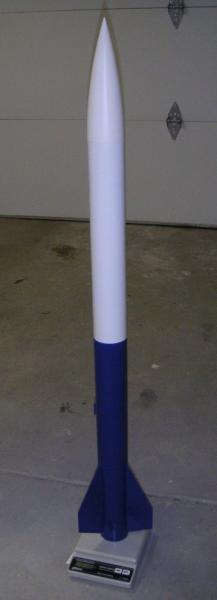 Brief:
Brief:
The DX3 is a fairly simple 2.6" diameter 3FNC mid-power rocket with a large payload section.
Construction:
The kit is complete, with a pre-slotted body tube, a payload tube, plastic nose cone, 3 laser-cut 1/8" plywood
fins, 29mm 8" cardboard MMT, plywood centering rings, a cardboard coupler with plywood bulkhead, a Nomex®
chute protector, a Kevlar®/Nylon
shock cord (total length about 8 feet), eyebolt and washers, 1/4" launch lugs, and a 24" nylon parachute. All
tubes are heavy-duty cardboard.
This was my first MPR build and being of the balsa generation of LPR, I wanted to avoid the plastic-fins route.
The kit quality was excellent and I had little trouble dry-fitting everything. I basically followed the instructions, with the exception that (per the excellent review of the Madcow Cowabunga on EMRR) I left the aft centering ring off so I could put internal fillets on the fins and MMT, and I used 30-minute epoxy for the centering rings (which is a pain if you're an impatient builder like me; I'm sure 5-minute would have been fine.)
I also bought the Madcow motor retention kit, which is a metal plate that attaches to the aft centering ring with two 6-32 cap screws into brass inserts. The only gotcha for me was that the inserts are quite close to the ID of the centering ring and I had trouble drilling and screwing them in without breaking through the plywood. I also found it hard to thread them straight in. But with some epoxy I didn't have any problem.
I thought about building this zipperless by drilling some holes in the coupler bulkhead and attaching the coupler to the lower body tube, but decided to not get fancy this time around. (Minor issue with the instructions: they say to attach the shock cord to the nose cone, but of course it goes to the eyebolt in the coupler.)
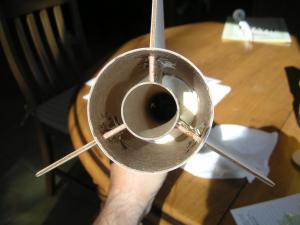
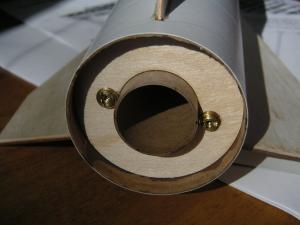
The biggest problem I had was that the coupler required a fair bit of sanding to get a proper fit into the body tube and even then it's still pretty snug.
The instructions also didn't say anything about how to attach the NC to the payload section, so I friction-fitted it with masking tape.
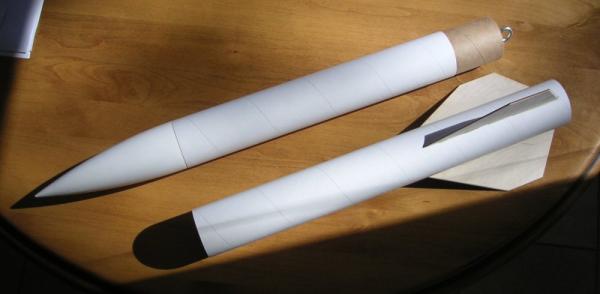
Finishing:
Finishing used two coats of watered Elmer's Wood Filler with 220 grit sanding on the fins, then one coat of Rustoleum
Painter's Touch white primer, 400 grit dry sanding, and then a coat of Painter's Touch Deep Blue on the lower and Gloss
White on the upper. I left the NC bare; Madcow recommends multiple coats of plastic primer on the NC, but I was lazy.
Note that the vendor site gives a weight of 15 oz but mine ended up at 18.2 oz and Rocksim estimates around 17 oz.
Construction Rating: 4 out of 5
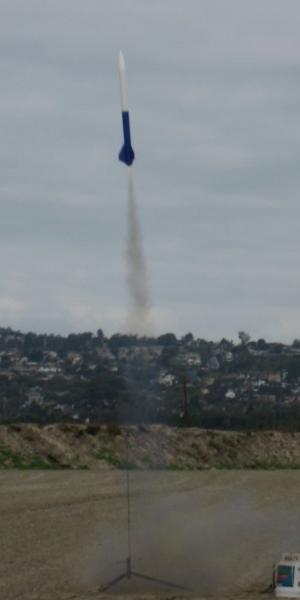 Flight:
Flight:
Though the smallest recommended motor was an F20, the first flight was on a fairly small field, so I went with an
E30-4T, which simmed to about 500 feet. The Madcow 24-29mm adapter was used; this has a thrust ring front and back, and
a 24mm Madcow retainer was used on the DX3.
Like other Madcow models, the DX3 uses a Nomex® chute protector so no wadding is needed. It's easy to get everything above the Kevlar® portion of the shock cord wrapped up in the protector.
The first flight was straight and went to about the expected altitude, though the NC came off the payload section at ejection and fell free (no damage landing on packed sand); there were some blue paint marks on the white payload section, so the sections hit each other at some point (7' of shock cord may not be enough given the large and fairly heavy forward section.)
Recovery:
The chute deployed normally and the descent rate was about right, maybe a little fast, but that kept it on the field
better.
In a total of four flights, all on E30-4T, the NC came off twice despite progressively more tape, and there was a small dent in the bottom edge of the tube from the landing (since the fins are above the end of the body tube, the tube ends up taking the landing impact.)
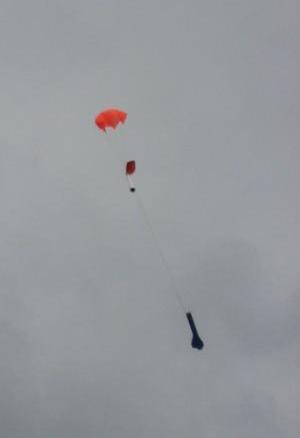
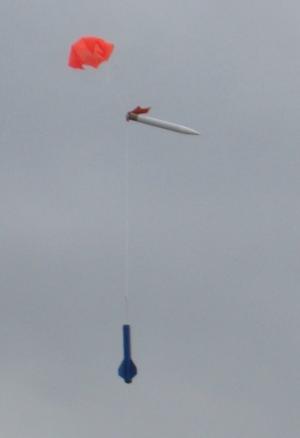
Flight Rating: 4 out of 5
Summary:
The kit quality is extremely good and I enjoyed the build. I'm looking forward to trying larger motors. With the
large payload section you could imagine building this for dual-deployment easily.
The biggest con is that you really need to make sure that the NC is well-attached to the payload section. Since the NC is pretty heavy (over four ounces) friction-fitting may not be effective. Removable rivets or rivet nuts would probably work well.
A longer shock cord might lessen the deployment forces.
Overall Rating: 4 out of 5
Other:
You may want to strengthen the bottom of the body tube with a doubler and some epoxy since it'll bear the burden of
impact.
 |
 |
Flights
 |
 |